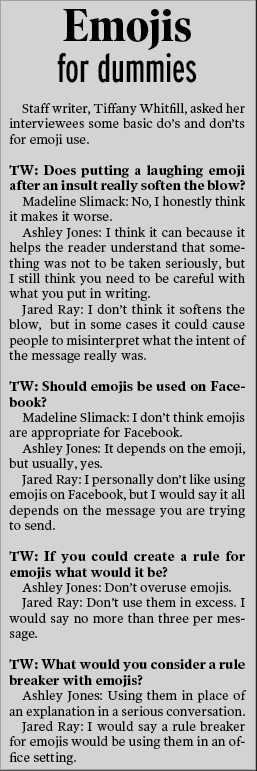In a generation where Instagram feeds are covered with food and selfies and Twitter is plastered with hashtags, text messages have their own symbolic character, emojis.
Communication is changing form as fast as our thumbs can type.
An added visual element to our texts are emoji keyboards. With more than five categories and 32 pages of emojis to choose from on the Apple iPhone alone, some students think there are both pros and cons to using the characters.
Time magazine decided to investigate the use of emojis and cited Tyler Schnoebelen’s thesis work that was based solely on the use of emoticons.
In his research, Schnoebelen found interesting statistics about the usage of emojis in Twitter or casual text conversations.
“(Emojis) act like punctuation, providing cues about how to understand the words that came before them, as an exclamation point might,” Time magazine staff writer Katy Steinmetz said.
While sentence structure may seem appropriate for text messages, the order in which emojis are sent has also shown statistical background through research.
Schnoebelen said that emojis can deliver a storyline and the order that emojis are sent can represent a completely different plot.
“A different order could convey an entirely different idea or story, when we’re used to reading our narratives from left to right,” Schnoebelen said.
Ashley Jones, senior from Highlands Ranch, Colo., said that emojis help communication because they add another element to texting.
Jones said that there are certain times when emojis are appropriate.
“Emojis are good for casual conversations with friends but should not be used when texting a superior,” she said.
Jared Ray, junior from Murray, agreed that emojis can help communication, especially in conditions where the meaning of the text can be misinterpreted.
“I don’t think emojis are hurting communication,” Ray said. “I think in some ways it makes texting more effective because you can actually show emotion and people can actually figure out if you’re trying to use sarcasm or something like that.”
With more than 250 emojis, users can express their emotions, show what they are doing or provide comedic relief in an otherwise ordinary conversation.
Madeline Slimack, senior from Belleville, Ill., said that emojis help her understand when the sender is happy, sad or angry.
Jones also said she thinks people use emojis as non-verbal cues when they are texting because she thinks they are a simple way to translate emotion.
To some, the benefits of using emojis outweigh any rules that others may set for them. Slimack said she uses emojis all the time.
In contrast, both Ray and Jones said they try use emojis when explaining how they feel.
“I use them sparingly with close friends,” Jones said.
While there are both written and unwritten rules for when to use emojis, some students say it is a personal preference.
Story by Tiffany Whitfill, Staff writer